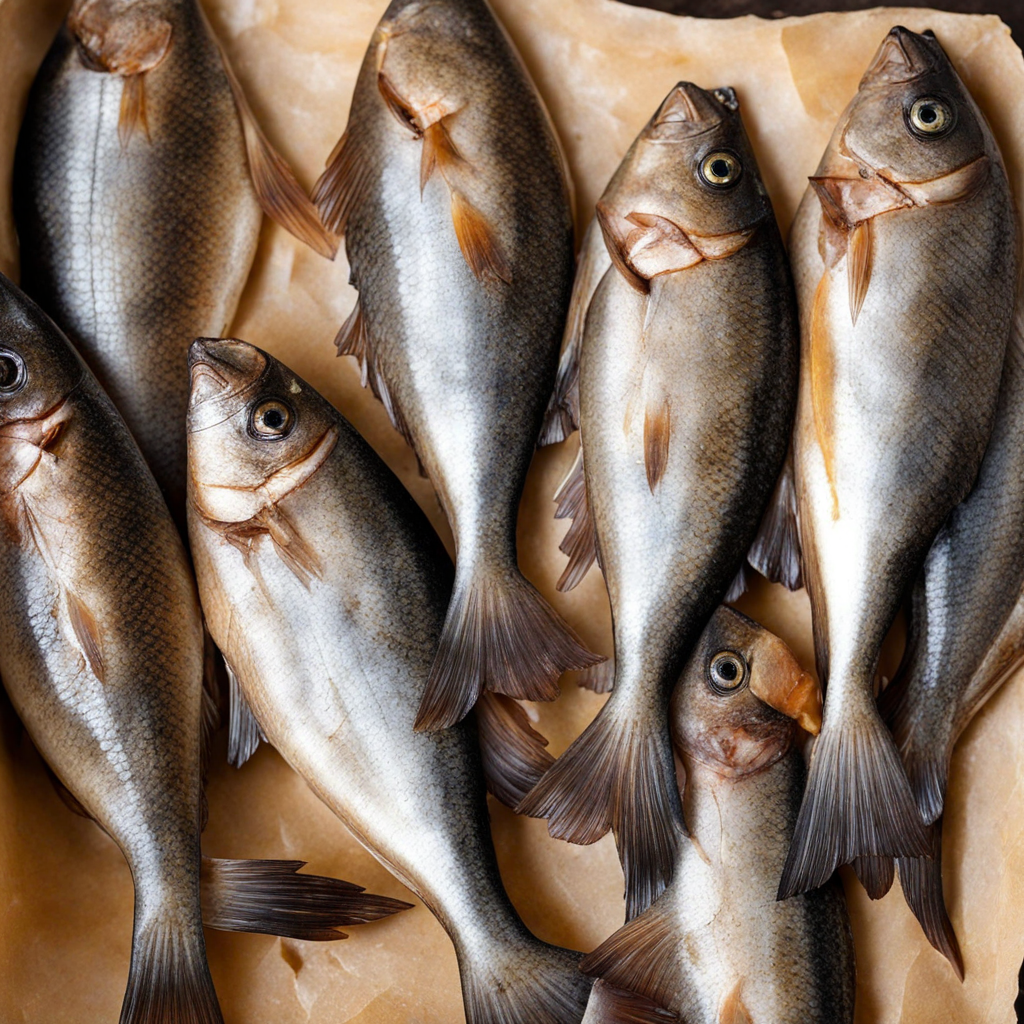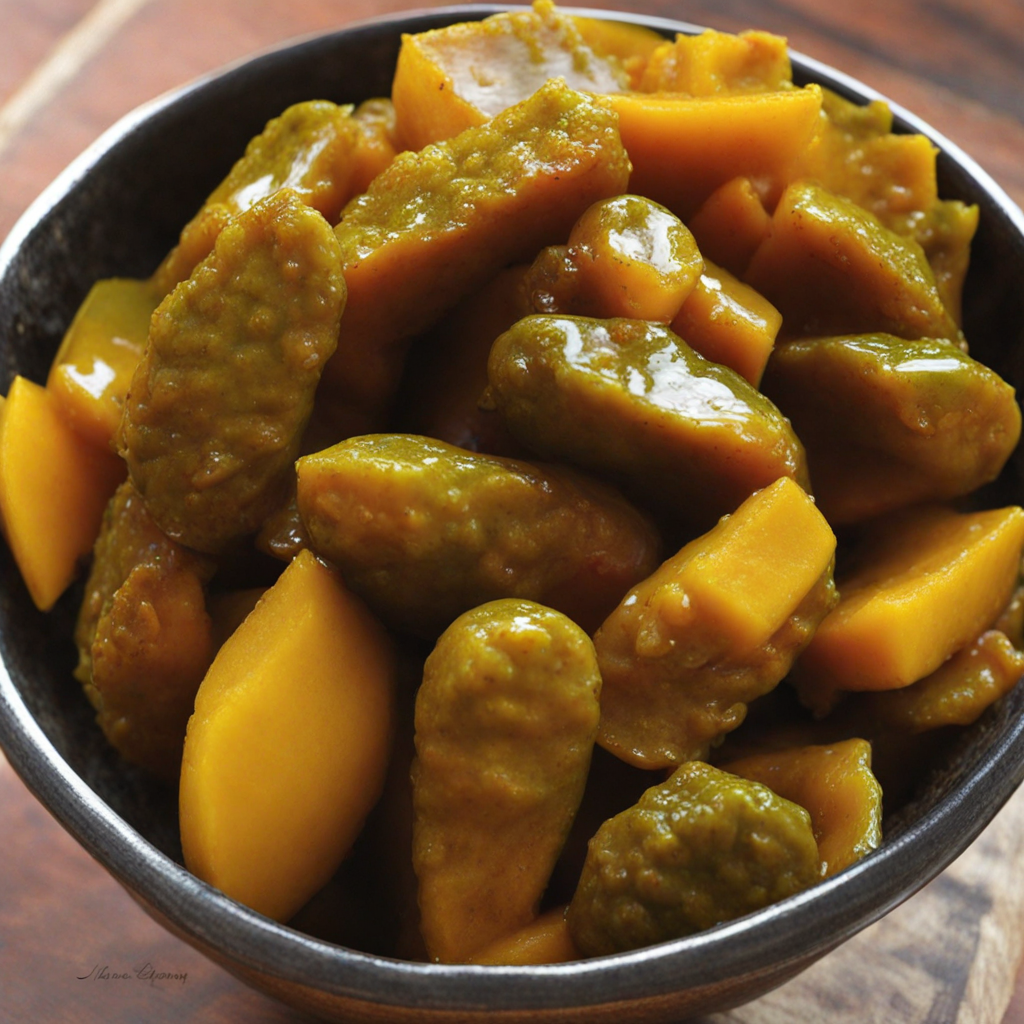Smoked Fish
Smoked fish in Burkina Faso is a culinary delight that showcases the country's rich traditions and diverse flavors. The fish, often sourced from local rivers such as the Comoé or the Mouhoun, is carefully selected for its freshness. Common varieties include tilapia and catfish, which are known for their firm texture and mild flavor. The smoking process involves marinating the fish in a blend of spices, herbs, and a touch of local palm oil, enhancing its natural taste before being hung over a smoldering fire, often made from wood or leaves. This method not only preserves the fish but infuses it with a deep, smoky aroma that tantalizes the senses. The texture of smoked fish is a remarkable contrast to its traditional counterparts; it is slightly chewy yet succulent, offering a satisfying bite. When you take a piece, the first thing you notice is the rich, smoky flavor that envelops your palate, followed by the warmth of the spices that dance within each bite. This dish is often enjoyed with traditional accompaniments such as tô (a type of dough made from millet or sorghum) or served alongside a vibrant vegetable relish, creating a delightful balance of flavors and textures on the plate. Smoked fish is not just a dish; it is a part of the social fabric in Burkina Faso, often enjoyed during gatherings and celebrations. The communal aspect of sharing a meal enhances the experience, as friends and family come together to savor the unique flavors. Whether eaten as a snack, a main dish, or as part of a festive feast, smoked fish offers a taste of Burkina Faso's culinary heritage that is both memorable and inviting, encouraging food lovers to explore the depths of its rich gastronomic landscape.
How It Became This Dish
The History of Poisson Fumé: A Culinary Treasure from Burkina Faso #### Origins and Traditional Practices Poisson Fumé, or smoked fish, holds a significant place in the culinary landscape of Burkina Faso, a landlocked country in West Africa characterized by its diverse ethnic groups and rich cultural heritage. While the exact origins of Poisson Fumé are difficult to pinpoint, the practice of smoking fish can be traced back centuries, likely influenced by the indigenous populations residing near the shores of Lake Volta and various rivers that crisscross the region. Historically, fishing was not just a means of sustenance for the communities around water bodies; it was also a vital aspect of their cultural identity. The art of smoking fish emerged as a practical preservation technique in a climate where refrigeration was absent. By smoking fish, communities could extend the shelf life of their catch, ensuring that they had a reliable food source even during the leaner seasons. The traditional method of preparing Poisson Fumé involves cleaning the fish, often varieties such as tilapia or catfish, and marinating it in local spices. The fish is then hung over a smoking fire, typically made from wood, which imparts a distinct flavor while preserving the protein-rich flesh. This method of smoking not only enhances the flavor but also adds a unique aroma that is cherished in Burkinabé cuisine. #### Cultural Significance In Burkina Faso, food is deeply intertwined with culture and social practices. Poisson Fumé is more than just a dish; it is a symbol of communal life and shared traditions. In many societies, the preparation of smoked fish is a communal activity, often involving families and neighbors coming together. This practice fosters bonds among community members and reinforces cultural ties. Moreover, Poisson Fumé plays a crucial role in traditional ceremonies and celebrations. It is commonly served during significant events such as weddings, festivals, and religious observances. The dish is often accompanied by staple foods like tô (a dough-like dish made from millet or corn) or rice, making it a staple part of communal feasting. The dish also holds economic significance for many who rely on fishing as their primary source of income. The art of smoking fish has enabled local fishermen to sell their products in distant markets, boosting the local economy and providing livelihoods for countless families. As such, Poisson Fumé is emblematic of not only cultural identity but also economic resilience and adaptability. #### Evolution and Modern Influences As Burkina Faso has evolved, so too has the practice of making Poisson Fumé. The advent of globalization and urbanization has introduced new ingredients and techniques to the traditional methods of preparing smoked fish. While the essence of Poisson Fumé remains rooted in its traditional practices, modern influences have led to innovative interpretations of the dish. In urban areas, for instance, the introduction of electric smokers has transformed the way Poisson Fumé is prepared, allowing for greater consistency and efficiency. While purists may argue that this method lacks the authenticity of traditional wood smoking, it has made the dish more accessible to a wider audience and has helped to popularize it beyond local markets. Additionally, the fusion of flavors has become a hallmark of contemporary Burkinabé cuisine. Chefs and food enthusiasts are experimenting with various spices and marinades, incorporating elements from other culinary traditions. For example, the integration of ingredients like garlic, ginger, and chili pepper has added a new dimension to the flavor profile of Poisson Fumé, appealing to a broader palate while still respecting its traditional roots. #### Poisson Fumé in the Global Context As the world becomes increasingly interconnected, Poisson Fumé has found its way onto international menus, celebrated for its unique flavor and cultural significance. In recent years, there has been a growing interest in African cuisines, with chefs and food bloggers showcasing traditional dishes from the continent. Poisson Fumé has garnered attention as a dish that encapsulates the rich tapestry of flavors and traditions found in Burkina Faso. Food festivals, cultural events, and culinary workshops have also contributed to the global appreciation of Poisson Fumé. Through these platforms, chefs not only share the dish but also educate others about the cultural narratives tied to it. This has fostered a greater understanding of Burkinabé cuisine and its role in the larger context of African culinary traditions. #### Challenges and Sustainability Despite its rich history and cultural significance, the art of making Poisson Fumé faces challenges in the modern world. Overfishing, climate change, and environmental degradation threaten the fish populations in Burkina Faso's lakes and rivers. As a result, communities that rely on fishing for their livelihoods are increasingly vulnerable. Efforts are being made to promote sustainable fishing practices and to educate local communities about the importance of preserving aquatic ecosystems. Organizations and NGOs are working alongside local fishermen to implement measures that ensure the sustainability of fish stocks while maintaining the cultural practices tied to Poisson Fumé. #### Conclusion Poisson Fumé stands as a testament to the resilience and adaptability of Burkinabé culture. From its origins as a practical preservation method to its role in communal feasting and economic sustenance, the dish has evolved while maintaining its deep-rooted significance. As it continues to gain recognition on the global stage, Poisson Fumé not only delights the palate but also serves as a bridge connecting people to the rich cultural heritage of Burkina Faso. The future of Poisson Fumé lies in balancing tradition with innovation, ensuring that this cherished dish continues to thrive while respecting both the environment and the cultural practices that have sustained it for generations. Whether enjoyed in a bustling market or a fine dining restaurant, Poisson Fumé remains an emblem of the culinary and cultural richness of Burkina Faso, inviting all to savor its smoky, flavorful essence.
You may like
Discover local flavors from Burkina Faso







